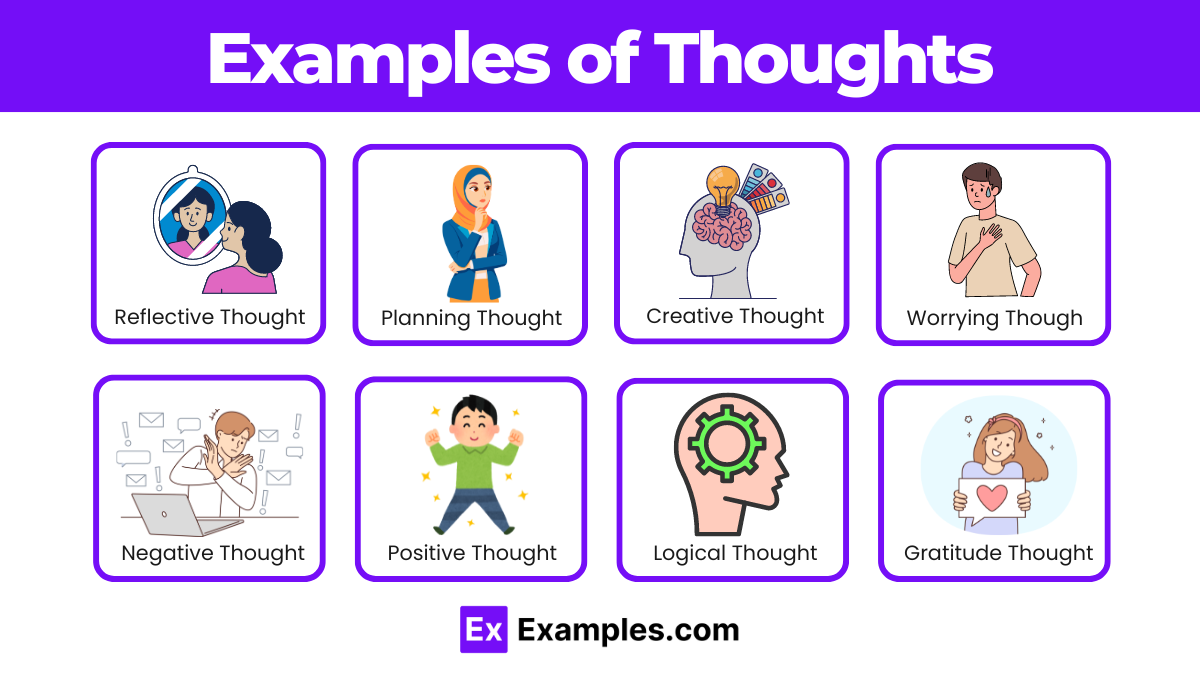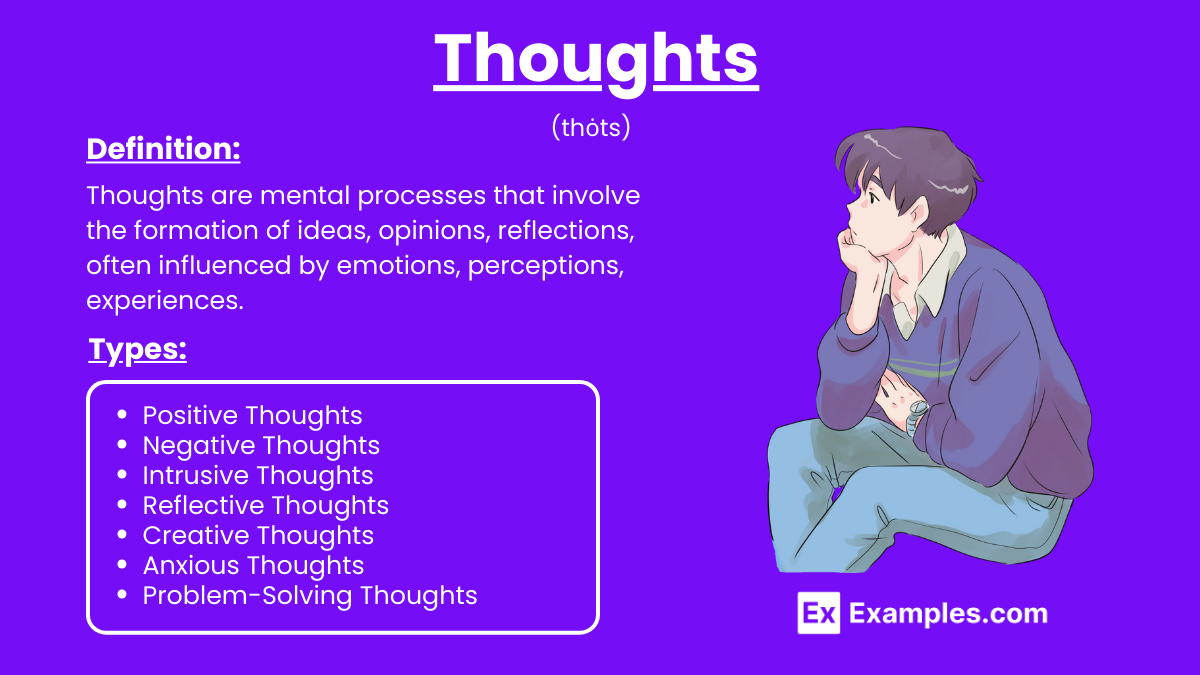50+ Thoughts Examples
Intrusive thoughts are unwelcome, involuntary thoughts that often cause distress. These thoughts can interfere with daily life, disrupting one’s focus and sense of well-being. Understanding the characteristics of intrusive thoughts is crucial, as they can sometimes conflict with personal values or vows, challenging one’s intrinsic motivation to maintain a positive mindset. Addressing these thoughts involves recognizing their nature and developing strategies to manage them effectively.
What are Thoughts?
Thoughts are mental processes involving the generation of ideas, images, or concepts within the mind. They encompass a wide range of cognitive activities, from problem-solving and decision-making to daydreaming and reflecting.
Examples of Thoughts

- Reflective Thought: “What did I learn from today’s experience?”
- Problem-Solving Thought: “How can I resolve this issue at work?”
- Planning Thought: “What should I include in my travel itinerary?”
- Decision-Making Thought: “Should I accept the job offer or wait for another opportunity?”
- Creative Thought: “How can I improve my painting technique?”
- Worrying Thought: “What if I don’t meet the deadline?”
- Daydreaming Thought: “Imagine living in a beach house.”
- Self-Critical Thought: “I could have handled that situation better.”
- Motivational Thought: “I can achieve my goals if I stay focused.”
- Reminiscent Thought: “I remember the fun times we had in college.”
- Analytical Thought: “Why did the market react this way?”
- Judgmental Thought: “That was a rude comment.”
- Curious Thought: “How does this technology work?”
- Empathetic Thought: “I wonder how she feels about the news.”
- Strategic Thought: “What’s the best approach to this project?”
- Future-Oriented Thought: “Where do I see myself in five years?”
- Self-Affirming Thought: “I am capable and resilient.”
- Negative Thought: “I can’t do anything right.”
- Positive Thought: “Today is going to be a good day.”
- Intrusive Thought: “What if something bad happens?”
- Fantasizing Thought: “Winning the lottery would change my life.”
- Logical Thought: “If A equals B and B equals C, then A equals C.”
- Gratitude Thought: “I am thankful for my supportive friends.”
- Regretful Thought: “I wish I had taken that opportunity.”
- Hopeful Thought: “Maybe tomorrow will be better.”
- Comparative Thought: “She seems more successful than me.”
- Insightful Thought: “I just realized why I feel this way.”
- Observation Thought: “The sky is particularly clear today.”
- Critical Thought: “This argument has several flaws.”
- Philosophical Thought: “What is the meaning of life?”
Positive Thoughts Examples
- “I am capable of achieving my goals.”
- “Today is going to be a great day.”
- “I am grateful for the love and support of my family.”
- “Every challenge is an opportunity to grow.”
- “I believe in my ability to succeed.”
- “I am proud of my accomplishments.”
- “I am surrounded by positivity and happiness.”
- “I can handle anything that comes my way.”
- “I am constantly improving and learning.”
- “I deserve to be happy and fulfilled.”
Negative Thoughts Examples
- “I can’t do anything right.”
- “I’m not good enough.”
- “Everything always goes wrong for me.”
- “I’ll never be successful.”
- “People don’t like me.”
- “I’m a failure.”
- “I always make mistakes.”
- “I’m not smart enough to understand this.”
- “Nothing ever works out for me.”
- “I’m worthless.”
Intrusive Thoughts Examples
- Unwanted Impulses: “What if I suddenly scream during this meeting?”
- Violent Imagery: “I keep picturing a car accident happening.”
- Inappropriate Urges: “What if I blurt out something offensive?”
- Self-Doubt: “What if I’m actually not good at my job?”
- Catastrophic Thinking: “What if my loved ones get hurt?”
- Health Anxiety: “What if this headache is something serious?”
- Relationship Worries: “What if my partner stops loving me?”
- Existential Questions: “What if none of this really matters?”
- Compulsive Thoughts: “Did I lock the door? I should check again.”
- Social Anxiety: “What if I embarrass myself in front of everyone?”
Anxiety Thoughts Examples
- “What if something bad happens to my family?”
- “I can’t handle this situation; it’s too overwhelming.”
- “What if I fail this test and ruin my future?”
- “People are judging me and thinking negatively about me.”
- “What if I get sick and can’t recover?”
- “I don’t know how I’ll cope if things go wrong.”
- “What if I embarrass myself in front of everyone?”
- “I’m not prepared for this, and I’m going to mess up.”
- “What if I have a panic attack and can’t control it?”
- “I can’t stop worrying about all the things that could go wrong.”
Types of Thoughts
Positive Thoughts: These thoughts focus on the good aspects of life and encourage optimism. Example: “I am capable of achieving my goals.”
Negative Thoughts: These thoughts often involve self-criticism, doubt, and pessimism. Example: “I can’t do anything right.”
Intrusive Thoughts: These are unwelcome and involuntary thoughts that can be disturbing. Example: “What if something bad happens to my family?”
Reflective Thoughts: These involve introspection and analysis of past experiences. Example: “What did I learn from that mistake?”
Creative Thoughts: These thoughts are imaginative and innovative, often leading to new ideas. Example: “How can I improve this design?”
Anxious Thoughts: These are worry-driven thoughts focused on potential future problems. Example: “What if I fail this exam?”
Problem-Solving Thoughts: These are logical and analytical thoughts aimed at finding solutions. Example: “How can I fix this issue at work?”
How Negative Thinking Leads To Depression
Reinforces Negative Beliefs: Negative thinking often reinforces existing negative beliefs about oneself, leading to a persistent cycle of self-doubt and low self-esteem.
Increases Stress and Anxiety: Constant negative thoughts increase stress and anxiety levels, making it difficult to cope with daily challenges and contributing to feelings of hopelessness.
Distorts Perception of Reality: Negative thinking distorts the perception of reality, causing individuals to focus more on their failures and overlook their achievements, which can deepen depressive feelings.
Decreases Motivation: Persistent negative thoughts can sap motivation and energy, making it hard to engage in activities that once brought joy and fulfillment, thus exacerbating depressive symptoms.
Where Do Negative Thoughts Come From / What Commonly Triggers Them?
Past Experiences: Traumatic or negative past experiences can leave lasting impressions that trigger negative thoughts. For example, a history of failure or rejection may lead to ongoing self-doubt.
Stressful Situations: High levels of stress from work, school, or personal life can trigger negative thoughts. These thoughts often arise as a reaction to feeling overwhelmed or unable to cope.
Anxiety and Depression: Mental health conditions like anxiety and depression can generate and amplify negative thoughts. These conditions often cause individuals to focus on the worst-case scenarios.
Cognitive Distortions: Distorted thinking patterns, such as catastrophizing or overgeneralizing, can lead to negative thoughts. These patterns cause people to view situations more negatively than they really are.
Negative Self-Talk: Persistent negative self-talk can trigger and maintain negative thoughts. This internal dialogue often includes harsh self-criticism and doubt.
Environmental Influences: Negative influences from the environment, such as toxic relationships or negative media, can trigger negative thoughts. Being surrounded by negativity can affect one’s mindset.
Physical Health Issues: Poor physical health or chronic illness can contribute to negative thoughts. The stress and discomfort of health issues can make it harder to maintain a positive outlook.
Unrealistic Expectations: Setting unrealistic goals and expectations can lead to negative thoughts when these goals are not met. This often results in feelings of failure and inadequacy.
List of Moods, Behaviors, Situations and Thoughts
| Moods | Behaviors | Situations | Thoughts |
|---|---|---|---|
| Happy | Smiling | Family gatherings | “I love spending time with my family.” |
| Sad | Crying | Loss of a loved one | “I miss them so much.” |
| Anxious | Fidgeting | Public speaking | “What if I mess up?” |
| Angry | Yelling | Argument with a friend | “Why can’t they understand me?” |
| Excited | Energetic | Starting a new job | “I can’t wait to begin!” |
| Depressed | Withdrawing | Prolonged isolation | “Nothing matters anymore.” |
| Frustrated | Clenching fists | Technical difficulties | “Why won’t this work?” |
| Relaxed | Deep breathing | Vacation at the beach | “This is so peaceful.” |
| Fearful | Avoidance | Facing a phobia | “I can’t do this.” |
| Content | Sighing with relief | Completing a project | “I’m proud of my work.” |
| Confident | Speaking clearly | Successful presentation | “I did a great job.” |
| Guilty | Apologizing | Making a mistake | “I shouldn’t have done that.” |
| Overwhelmed | Procrastinating | Multiple deadlines | “I can’t handle all of this.” |
| Curious | Asking questions | Exploring a new hobby | “How does this work?” |
| Lonely | Seeking company | Moving to a new city | “I don’t know anyone here.” |
How do thoughts affect behavior?
Thoughts influence behavior by shaping our actions and reactions.
Can thoughts be controlled?
Yes, with practice and techniques like mindfulness and cognitive-behavioral therapy, individuals can learn to manage and redirect their thoughts more effectively.
What is the difference between direct and indirect characterization of thoughts?
Direct characterization explicitly describes a character’s thoughts, while indirect characterization reveals thoughts through actions, dialogue, and expressions.
Why do we have negative thoughts?
Negative thoughts can stem from past experiences, stress, anxiety, or cognitive distortions, influencing our mood and perception of situations.
How can we change negative thoughts?
Changing negative thoughts involves recognizing them, challenging their validity, and replacing them with positive or realistic alternative
What is the role of thoughts in indirect characterization?
Indirect characterization uses characters’ actions and dialogue to reveal their thoughts and feelings, allowing readers to infer mental states.
What triggers intrusive thoughts?
Intrusive thoughts can be triggered by stress, anxiety, trauma, or certain mental health conditions.
How do creative thoughts arise?
Creative thoughts arise from imagination and innovation, allowing individuals to generate new ideas and solutions
What is the importance of understanding thoughts in characterization?
Understanding thoughts in characterization provides insight into a character’s inner life, making them more relatable and complex for the audience.
How do thoughts impact mood?
Thoughts significantly impact mood; positive thoughts can enhance happiness, while negative thoughts can contribute to sadness or anxiety.



